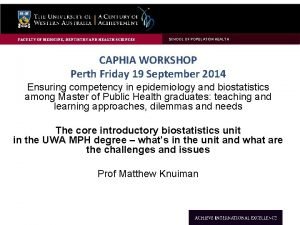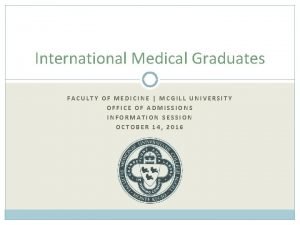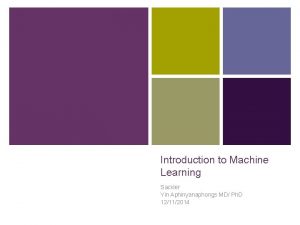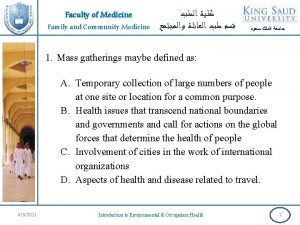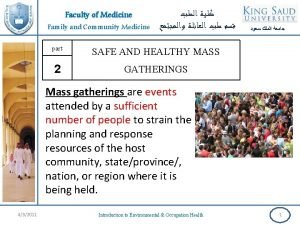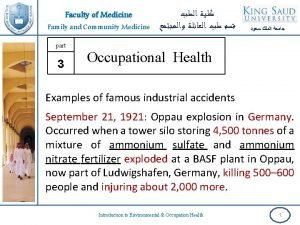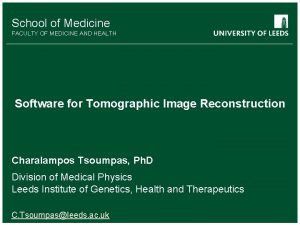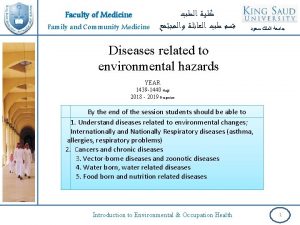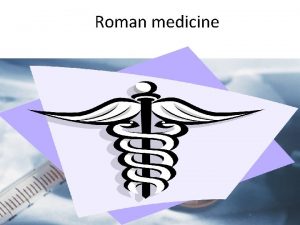The Sackler Faculty of Medicine Dr Miriam and














- Slides: 14

The Sackler Faculty of Medicine Dr. Miriam and Sheldon G. Aldeson Graduate School of Medicine Department of Clinical Microbiology and Immunology Tel Aviv University Feverlike Temperature is a Virulence Regulatory Cue Controlling the Motility and Host Cell Entry of Typhoidal Salmonella Dana S. Elhadad, Ph. D candidate Infectious Disease Unit Sheba Medical Center Advisors: Dr. Ohad Gal-Mor Prof. Galia Rahav

Salmonella Taxonomy : the family Enterobacteriaceae q Gram-negative q Facultative intracellular q Fecal-Oral Route q Possesses two classical T 3 SSs : Salmonella pathogenicity island 1 (SPI-1) and 2 (SPI-2) q Predominantly flagellated

Salmonella Taxonomy : the family Enterobacteriaceae q Different degree of host adaptation: Host generalist : S. Typhimurium S. Enteritidis Non-Typhoidal Serovars: Gastroenteritis VS. Host restricted : S. Sendai, S. Typhi and S. Paratyphi A Typhoidal serovars: Enteric Fever ü Localized ü Systemic ü Short incubation period ü Long incubation period ü Brief duration ü Long duration ü Symptoms : ü Symptoms: Diarrhea Fever Nausea Generalized pain Gal-Mor, Ohad, Erin C. Boyle, and Guntram A. Grassl. "Same species, different diseases: how and why typhoidal and non-typhoidal Salmonella enterica serovars differ. " Frontiers in microbiology 5 (2014).

Host Cell Entry by Salmonella at Fever Temperature Typhoidal serovar : S. Paratyphi A NTS serovar: S. Typhimurium I. S. Paratyphi A invasion is significantly affected by elevated temperatures Elhadad, D. , Mc. Clelland, M. , Rahav, G. , & Gal-Mor, O. (2014). Feverlike Temperature is a Virulence Regulatory Cue Controlling the Motility and Host Cell Entry of Typhoidal Salmonella. Journal of Infectious Diseases, jiu 663.

Transepithelial Electrical Resistance (TEER) of Caco-2 cells Following Salmonella Invasion I. Elevated temperature affects S. Paratyphi A ability to disrupt epithelial monolayer integrity

SPI-1 Expression Under Fever-like Temperatures STM SL 1344 Regulators I. Structural SPA 45157 Effector SPI-1 expression is significantly lower at 42°C in S. Paratyphi A relative to S. Typhimurium

SPI-1 Mediated Invasion Under Fever-like Temperatures STM SL 1344 37°C I. STM SL 1344 42°C SPA 45157 37°C SPA 45157 42°C The impaired invasion of S. Paratyphi A at the fever temperature occurs in a TTSS-1 -independent manner

Thermoregulated motility : 0. 3% agar swim plates Typhoidal serovars NTS serovars S. Typhimurium 37°c 42°c S. Enterititis S. Paratyphi A S. Typhi S. Sendai

Thermoregulated motility : 0. 3% agar swim plates STM SL 1344 SPA 45157 Class I. I II III Specifically class II and III genes of the flagella/ chemotaxis regulon in S. Paratyphi A, but not in S. Typhimurium are down-regulated at 42°C

Motility and Invasion at Fever Temperature of Typhoidal Serovars I. Impaired motility and invasion at fever temperature are common to typhoidal serovars

Conclusions • • Epithelial cell invasion by S. Paratyphi A is impaired at 42°C The invasion of S. Paratyphi A at 42 °C is T 3 SS-1 -independent • • S. Paratyphi A motility is impaired at 42°C The class II and III of the flagella/ chemotaxis regulon is downregulated in S. Paratyphi A at 42°C • Impaired motility and invasion at elevated temperatures is common to all human-adapted Salmonella serovars Our results suggest that the clinical symptom of fever is used by typhoidal serovars as a key environmental cue affecting hostpathogen interaction during infection

Conclusions • • Epithelial cell invasion by S. Paratyphi A is impaired at 42°C The invasion of S. Paratyphi A at 42 °C is T 3 SS-1 -independent • • S. Paratyphi A motility is impaired at 42°C The class II and III of the flagella/ chemotaxis regulon is downregulated in S. Paratyphi A at 42°C • Impaired motility and invasion at elevated temperatures is common to all human-adapted Salmonella serovars Fever Initial invasive stage of the infection required to reach deeper tissue Persistent phase lessens repetitive cycles of reseeding Control bacterial load in the blood, avoid sepsis and host death

Acknowledgements The Infectious Diseases Laboratory Tel-Hashomer Advisors : Dr. Ohad Gal-Mor Prof. Galia Rahav Lab Members :

The most exciting phrase to hear in science, the one that heralds new discoveries, is not “Eureka” but “That's funny. . . ” —Isaac Asimov (1920– 1992)
 Sackler institute for developmental psychobiology
Sackler institute for developmental psychobiology Faculty of medicine nursing and health sciences
Faculty of medicine nursing and health sciences Pubh4401
Pubh4401 Hubert kairuki memorial university faculty of medicine
Hubert kairuki memorial university faculty of medicine Hyperparathyreosis
Hyperparathyreosis Applied medical sciences
Applied medical sciences Territorial matrix vs interterritorial matrix
Territorial matrix vs interterritorial matrix Faculty of veterinary medicine cairo university logo
Faculty of veterinary medicine cairo university logo Hacettepe university faculty of medicine
Hacettepe university faculty of medicine Conus arteriosus
Conus arteriosus Semmelweis university faculty of medicine
Semmelweis university faculty of medicine Faculty of medicine mcgill
Faculty of medicine mcgill Faculty of veterinary medicine cairo university
Faculty of veterinary medicine cairo university Emory dermatology clinic
Emory dermatology clinic Cairo university faculty of veterinary medicine
Cairo university faculty of veterinary medicine


